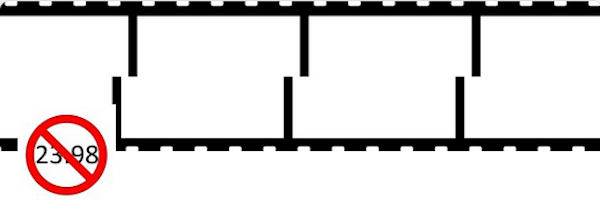[13:05 Tue,24.August 2021 by Thomas Richter] |
A number of film production professionals have set their sights on eliminating fractional (aka crooked) frame rates (such as 59.94 , 29.97 and 23.976 frames per second), as supporting them and working with them causes numerous problems and additional costs for all filmmakers.  Fractional frame rates were developed with the advent of color television as part of the NTSC standard to transmit movies traditionally shot at 24 fps slowed by 0.1% to avoid analog sound problems during transmission. This was done by converting the 24 fps to 29.97 fps, then slowing the content down first to 23.976 fps, and then converting it to 29.97 fps via The current problem is that many cameras, especially in the consumer and semiprofessional sectors, use 24 frames per second according to their spec sheets, while in reality they use a rate of 23.976 frames per second to be compatible with NTSC. For example, it is common in editorial departments to receive footage at 23.976 frames per second that was supposedly recorded at 24 frames per second, but then has to be converted (including the audio) to work with it in the timeline of a video editing program. In the opinion of the "nomore2398" group, all of this is now just useless baggage from the past, dragged along out of inertia. The problems caused by crooked frame rates.- Higher costs for production and mastering, since both frame rates have to be taken into account. - Higher costs for distribution (storage, quality control, transfer, ...), since all assets have to be stored in both formats, which doubles the required storage space. - The fractional frame rates used have an infinite number of repeating decimal places, which leads to different values being used in practice (e.g. 23.98 or 23.976 is actually 23.97602397602397602397602323976023... the result of 24x(1000/1001) - Inaccurate frame rate is displayed on some recording and playback devices (it is indicated as 24 frames per second, while in reality it is 23.976 frames per second), causing editorial inconsistencies and synchronization problems. - Creation of two additional timecode systems: Drop-Frame and Non-Drop-Frame. - The 0.1% slows down further processing in the production pipeline, resulting in even more broken frame rates (such as 59.94 fps). - The adoption of high frame rate (HFR) technology will also be slowed due to the cost and complexity of supporting fractional frame rates. The "nomore2398" group&s proposals.- Fractional frame rate is a technology of the past and should be gradually phased out - Manufacturers should use straight frame rates (e.g. 24fps) and accurately specify the correct frame rate for each device - Industry should transport and display content at the intended frame rate - All stakeholders, content creators, industry leaders, television and film executives, editors and creatives to agree on a timeline from which newly launched devices will no longer support fractional frame rates. Why now?Why are filmmakers making these proposals now of all times? The advent of streaming services has greatly simplified the distruíbution chain - unlike broadcast, a program can be encoded in 24 frames per second and played back directly from the viewer&s device at that frequency. This eliminates the need to support crooked frame rates. While it can be argued that the curved frame rates are still needed for older formats and displays. However, in the rare case that an older display does not support 24fps or 30fps, the content can be converted to the frame rate then required by the particular playback device being used. How can I participate?Anyone working in the film industry can support the campaign by simply creating new content in a standard frame rate, saving many hours of labor, storage space and capital. You can also support the elimination of crooked frame rates via social media such as a deutsche Version dieser Seite: Weg mit den krummen Bildraten! Filmschaffende wollen 23,976 fps abschaffen |





